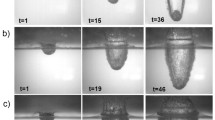Abstract
High-velocity impact onto a layered glass target produces a very extensive damage pattern exhibiting many distinct morphologies. Material around the penetration cavity is finely comminuted. Under the arrested projectile, the glass is largely intact with spoke-like fracture regions. Around the projectile cavity, needle fragments are formed; they are radial in outer layers and circumferential in inner layers. Extensive radial cracks occur in all layers, but the spacing and frequency of transverse fractures change in each layer. Damage from radial cracks also progresses from being hoop-stress-induced to flexural-induced through the depth of the target. Fan and dicing cracks occur near the periphery of the target. Mesoscale damage features include conventional mist and hackle markings indicating very fast cracks. The map of damage presented herein should be a valuable reference for attempts to model impact damage of glass.
Similar content being viewed by others
References
Anderson CE Jr, Chocran S, Walker JD (2005) Analysis of time-resolved penetration of long rods into glass targets. In: 29th International conference and exposition on advanced ceramics and composites, Cocoa Beach
Bless SJ (2009) Failure waves and their possible roles in determining penetration resistance of glass. Int J Appl Ceram Technol (in press)
Bless SJ, Brar NS (2007) Failure waves and their effects on penetration mechanics in glass and ceramics. In: Horie Y (ed) High pressure shock compression of solids, vol 1. Springer, pp 104–142
Bless SJ, Chen T, Russell R (2007) Impact on glass laminates. In: 23rd international symposium on ballistics, Tarragona, April 18–20
Bourne NK, Rosenberg Z, Field JE (1995) High-speed photography of compressive failure waves in glasses. J Appl Phys 76: 3726–3739
Brajer X, Forquin P, Gy R, Hild F (2003) The role of surface and volume defects in fracture of glass under quasi-static and dynamic loading. J Non Cryst Solids 316:42–53 (1995)
Chocran S, Anderson CE Jr, Nicholls AE, Rickmann R (2007) Constitutive model for borosilicate glass and application to long-rod penetration. In: 23rd international symposium on ballistics, Tarragona, Spain, April 18–20
Grinfeld MA, McCauley JW, Schoenfeld SI, Wright TW (2007) Failure patterns in brittle ceramics and glasses. In: 23th international symposium on ballistics, Tarragona, April 16–20
Holmquist TJ, Johnson GR, Grady DE, Lopatin CM, Hertel ES Jr (1995) High strain rate properties and constitutive modeling of glass. In: 15th International symposium on ballistics, Jerusalem, Israel, May 21–24
Hornemann U, Kaltoff J (1984) Experimental investigation of wave and fracture propagation in glass slabs loaded by steel cylinders at high velocities. Institute of Physics Conference Series No. 70, Oxford
Kanel GI, Bless SJ (2002) Compressive fracture of brittle solids under shock-wave loading. Ceramic armor materials by design. Ceram Trans 134: 197–216
Patel PJ, Gilde GA, Dehmer PG, McCauley JW (2000) Transparent ceramics for armor and EM window applications. Proc SPIE 4102
Quinn GD (2007) Fractography of ceramics and glasses. NIST Special Publication 960-6, pp 5–35
Ravi-Chandar K, Bisen L (2009) On non-planar crack growth under mixed-mode loading. Fracture (in press)
Rinehart JS (1975) Stress transients in solids. HyperDynamics, Santa Fe
Satapathy S, Bless S (2000) Cavity expansion resistance of brittle materials obeying a two-curve pressure shear behavior. J Appl Phys 88: 4004–4012
Stevenson ME, Jones SE, Bradt RC (2000) Fracture patterns of a composite safety glass panel during high velocity projectile impacts. Fractography of glasses and ceramics IV, American Ceramics Society
Strassburger E, Patel P, McCauley JW, Templeton DW (2005) High-speed photographic study of wave and fracture propagation in fused silica. In: 22nd international symposium on ballistics, Vancouver, November 14–18
Sun X, Khaleel A, Davies R (2005) Modeling of stone-impact resistance of monolithic glass ply using continuum damage mechanics. Int J Damage Mech 14: 165–178
Author information
Authors and Affiliations
Corresponding author
Rights and permissions
About this article
Cite this article
Bless, S., Chen, T. Impact damage in layered glass. Int J Fract 162, 151–158 (2010). https://doi.org/10.1007/s10704-009-9379-7
Received:
Accepted:
Published:
Issue Date:
DOI: https://doi.org/10.1007/s10704-009-9379-7




